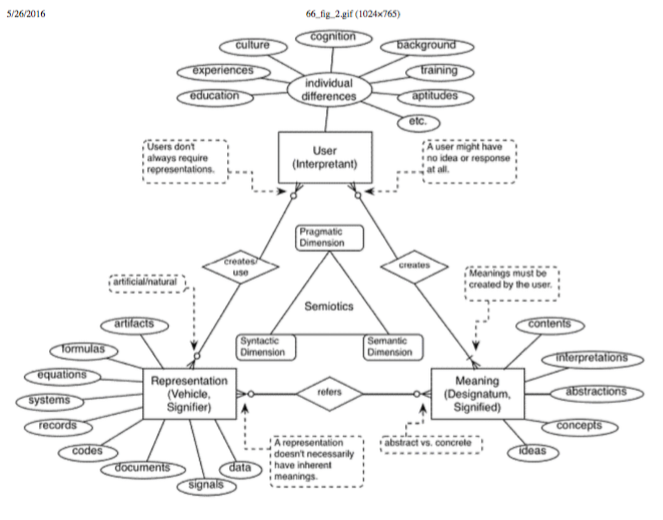 semiotics in a diagram extracted from ‘https://www.asis.org/Conferences/AM06/proceedings/papers/66/limages/66_fig_2.pdf
semiotics in a diagram extracted from ‘https://www.asis.org/Conferences/AM06/proceedings/papers/66/limages/66_fig_2.pdf
Semiotics is important because it can help us not to take ‘reality’ for granted as something having a purely objective existence which is independent of human interpretation. It teaches us that reality is a system of signs. Studying semiotics can assist us to become more aware of reality as a construction and of the roles played by ourselves and others in constructing it. It can help us to realize that
information or meaning is not ‘contained’ in the world or in books, computers or audio-visual media.
Meaning is not ‘transmitted’ to us – we actively create it according to a complex interplay of codes or conventions of which we are normally unaware. Becoming aware of such codes is both inherently fascinating and intellectually empowering. We learn from semiotics that we live in a world of signs and we have no way of understanding anything except through signs and the codes into which they are organized.
Through the study of semiotics we become aware that these signs and codes are normally transparent and disguise our task in ‘reading’ them. Living in a world of increasingly visual signs, we need to learn that even the most ‘realistic’ signs are not what they appear to be.
By making more explicit the codes by which signs are interpreted we may perform the valuable semiotic function of ‘denaturalizing’ signs. In defining realities signs serve ideological functions. Deconstructing and contesting the realities of signs can reveal whose realities are privileged and whose are suppressed.
The study of signs is the study of the construction and maintenance of reality. To decline such a study is to leave to others the control of the world of meanings which we inhabit.
Extracted from ‘Semiotics for Beginners by Daniel Chandler’
Caught between three world views as described in this passage:
Scientific knowledge is constructed socially by subjective minds interacting with nature. It, therefore, seems obvious that we have to admit that our inner “subjective” world is as foundational a part of reality as “objective” external nature and “intersubjective” social worlds.
But western scientific culture lacks a transdisciplinary framework that can encompass all three worlds without reducing any of them to byproducts of the development of one of the others. We need such a non-reductionistic framework more than ever as our basic problems often arise in the gaps between the recognized disciplines.
Interdisciplinary work needs a transdisciplinary framework for mutual orientation and context determination.
A sort of common map, so to speak, on which to point out, recognize and understand each other’s territories..
Extracted from: ‘The necessity of Trans-Scientific Frameworks for doing Interdisciplinary Research’ by Professor Søren Brier
Now, how do I apply the theory and the transdiscipinary framework for my research on data breach incident response?
It seems that on initial exploration, Peirce’s work on Semiotics provided the necessary framework in the form of Firstness, Secondness, Thirdness – Peirce’s ternary.